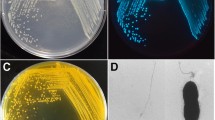Abstract
When expressed in heterologous microorganisms Vitreoscilla hemoglobin (VHb) acts as oxygen storage and causes a higher oxygen uptake. In this study, the effect of this protein on growth, sensitivity and antioxidant properties of Enterobacter aerogenes exposed to metal stress was investigated. The strain expressing VHb was more sensitive to mercury and cadmium as the minimal inhibitory concentration (MIC) for these metals was up to 2-fold lower in this strain than the host and the recombinant strain carrying a comparable plasmid. At lower concentrations than MIC, the metals partially limited growth and caused an inhibition proportional to metal concentration applied. The growth pattern of VHb expressing strain was also distinctly different from other two non-hemoglobin strains. The hemoglobin containing strain showed substantially higher superoxide dismuates (SOD) activity than the non-hemoglobin strains, while catalase levels were similar in all strains. All strains exposed to copper, however, showed similar MIC values, growth patterns, and SOD and catalase levels.
Similar content being viewed by others
References
Aebi H. 1984 Catalase in vitro. Methods Enzymol 105, 121–126.
Aldsworth TG, Sharman RL, Dodd CER. 1999 Bacterial suicide through stress. Cell Mol Life Sci 56, 378–383.
Boening DW. 2000 Ecological effects, transport, and fate of mercury: a general review. Chemosphere 40, 1335–1351.
Bornet C, Chollet R, Mallea M, Chevalier J, Davin-Regli A, Pages JM, Bollet C. 2003 Imipenem and expression of multidrug efflux pump in Enterobacter aerogenes. Biochem Bioph Res Co 301, 985–990.
Cohen SN, Chang ACY, Hsu AL. 1972 Non-chromosomal antibiotic resistance in bacteria: genetic transformation of Escherichia coli by R-factor DNA. Proc Natl Acad SciUSA 69, 2110–2114.
De Freitas J, Wintz H, Kim JH, Poynton H, Fox T, Vulpe C. 2003 Yeast, a model organism for iron and copper metabolism studies. Biometals 16, 185–197.
Dikshit KL, Webster DA. 1988 Cloning, characterization, and expression of the bacterial globin gene from Vitreoscilla in Escherichia coli. Gene 70, 377–386.
Dikshit RP, Dikshit KL, Liu YX, Webster DA. 1992 The bacterial hemoglobin from Vitreoscilla can support the aerobic growth of Escherichia coli lacking terminal oxidases. Arch Biochem Biophys 293, 241–245.
Ehrlich HL. 1997 Microbes and metals. Appl Microbiol Biotechnol. 48, 687–692.
Geckil H, Gencer S. 2004 Production of L-asparaginase in En-terobacter aerogenes expressing Vitreoscilla hemoglobin for efficient oxygen uptake. Appl Microbiol Biotechnol 63, 691–697.
Geckil H, Gencer S, Kahraman H, Erenler SO. 2003 Genetic engineering of Enterobacter aerogenes with Vitreoscilla hemoglobin gene: cell growth, survival, and antioxidant enzyme status under oxidative stress. Res Microbiol 154, 425–431.
Geckil H, Stark BC, Webster DA. 2001 Cell growth and oxygen uptake of Escherichia coli and Pseudomonas aeruginosa are differently effected by the genetically engineered Vitreoscilla hemoglobin gene. J Biotechnol 85, 57–66.
Hassen A, Saidi N, Cherif M, Boudabous A. 1998 Resistance of environmental bacteria to heavy metals. Bioresource Technol 64, 7–15.
Konopka A, Zakharova T. 1999 Quantification of bacterial lead resistance via activity assays. J Microbiol Meth 37, 17–22.
Lenartova V, Holovska K, Javorsky P. 1998 The inluence of mercury on the antioxidant enzyme activity of rumen bacteria Streptococ-cus bovis and Selenomonas ruminantium. FEMS Microbiol Ecol 27, 319–325.
Lowry OH, Rosebrough NJ, Farr AL, Randall RJ. 1951 Protein measurement with the Folin phenol reagent. J BioChem 193, 265–275.
McCord JM, Fridovich I. 1969 Superoxide dismutase: an enzymatic function for erythrocuprein (hemocuprein). J BiolChem 244, 6049–6055.
McCormick ML, Buettner GR, Britigan BE. 1998 Endogenous su-peroxide dismutase levels regulate iron-dependent hydroxyl rad-ical formation in Escherichia coli exposed to hydrogen peroxide. J Bacteriol 180, 622–625.
Messing J. 1983 New M13 vectors for cloning. Methods Enzymol. 101, 20–78.
Messner KR, Imlay JA. 1999 The identification of primary sites of superoxide and hydrogen peroxide formation in the aerobic respiratory chain and sulfite reductase complex of Escherichia coli. J Biol Chem 274, 10119–10128.
Miller JH. 1972 In: Experiments in molecular genetics, p. 433, Cold Spring Harbor Laboratory, Cold Spring Harbor, New York.
Minning DM, Gow AJ, Bonaventuras J, Braun R, Dewhirst M, Goldberg DE, Stamler JS. 1999 Ascaris haemoglobin is a nitric oxide-activated 'deoxygenase'. Nature 401, 497–502.
Nies DH. 2003 Efflux-mediated heavy metal resistance in proka-ryotes. FEMS Microbiol Rev 27, 313–339.
Nies DH. 1999 Microbial heavy-metal resistance. Appl Microbiol Biotechnol 51, 730–750.
Osborn AM, Bruce KD, Strike P, Ritchie DA. 1997 Distribution, diversity and evolution of the bacterial mercury resistance (me r) operon. FEMS Microbiol Rev 19, 239–262.
Roane TM, Pepper IL. 2000 Microbial Responses to Environment-ally Toxic Cadmium. Microb Ecol 38, 358–364.
Stocker R. 1990 Induction of hemoxygenase as a defense against oxidative stress. Free Radical Res Commun 9, 101–112.
Tsai PS, Rao G, Bailey JE. 1995 Iprovement of Escherichia coli mi-croaerobic oxygen metabolism by Vitreoscilla hemoglobin: new insights from NAD(P)H fluorescence and culture redox potential. Biotechnol Bioeng 47, 347–354.
Author information
Authors and Affiliations
Rights and permissions
About this article
Cite this article
Geckil, H., Arman, A., Gencer, S. et al. Vitreoscilla hemoglobin renders Enterobacter aerogenes highly susceptible to heavy metals. Biometals 17, 715–723 (2004). https://doi.org/10.1007/s10534-004-1216-x
Issue Date:
DOI: https://doi.org/10.1007/s10534-004-1216-x




